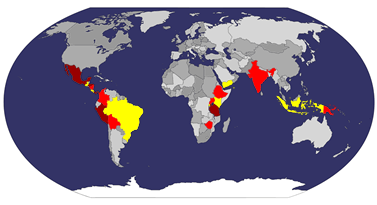There are 2 huge realities concerning the natural flavor
of coffee and here they are…
Location, location, location…
The first reality about coffee flavor is the bean itself,
because each coffee bean is from a specific crop, and each crop comes
from...you guessed it...a specific location.
Just as fine wine connoisseurs know wines by the specific grapes that
were used to produce it, so also fine coffees are known by the beans that were
used to brew the coffee. For instance,
Yemen’s coffees are known for their dominant mocha notes, the Jamaican Blue
Mountain is known because of its perfectly balanced flavor and smoothness, and
the Bali Blue Moon is known because of its a dominant fruitiness. The Bali Blue Moon has developed its dominant
flavor trait because it is grown between tangerine trees, and the fruit that
falls from those trees is what mulches the soil in which this coffee
grows.
After considering the location where the bean was grown,
we take a look at the weather in that location.
That’s right, the weather impacts the flavor of coffee beans. Each crop of coffee has grown with a very
specific amount of moisture in the air, rain fall, sunlight, and ambient
temperature. All of these “acts of God”
will shape the development of the flavor from each crop of coffee that is grown.
Then, after God has had His way with growing our coffee,
mankind gets our crack at influencing the flavor of our coffee through
processing, roasting, and flavor additives.
Processing is a topic of another post, and please don’t get me started
on flavor additives. However, in the second part of this blog post
I do want to talk about a couple of basic realities concerning the roasting
of coffee. So please stay tuned…
---
ADDENDUM:
The flavor of your coffee is determined by a variety of factors (the water, freshness of the bean, and the
ratio are big – see past post - but today I was speaking of the innate flavor of the bean itself.



 Red
Red  Yellow
Yellow 



























No comments:
Post a Comment